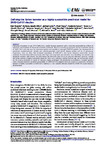Defining the Syrian hamster as a highly susceptible preclinical model for SARS-CoV-2 infection
| dc.contributor.author | Rosenke, K | |
| dc.contributor.author | Meade-White, K | |
| dc.contributor.author | Letko, M | |
| dc.contributor.author | Clancy, C | |
| dc.contributor.author | Hansen, F | |
| dc.contributor.author | Liu, Y | |
| dc.contributor.author | Okumura, A | |
| dc.contributor.author | Tang-Huau, T-L | |
| dc.contributor.author | Li, R | |
| dc.contributor.author | Saturday, G | |
| dc.contributor.author | Feldmann, F | |
| dc.contributor.author | Scott, D | |
| dc.contributor.author | Wang, Z | |
| dc.contributor.author | Munster, V | |
| dc.contributor.author | Jarvis, MA | |
| dc.contributor.author | Feldmann, H | |
| dc.date.accessioned | 2021-08-09T12:44:05Z | |
| dc.date.available | 2021-08-09T12:44:05Z | |
| dc.date.issued | 2020-12-25 | |
| dc.identifier.issn | 2222-1751 | |
| dc.identifier.issn | 2222-1751 | |
| dc.identifier.uri | http://hdl.handle.net/10026.1/17499 | |
| dc.description.abstract |
Following emergence in late 2019, SARS-CoV-2 rapidly became pandemic and is presently responsible for millions of infections and hundreds of thousands of deaths worldwide. There is currently no approved vaccine to halt the spread of SARS-CoV-2 and only very few treatment options are available to manage COVID-19 patients. For development of preclinical countermeasures, reliable and well-characterized small animal disease models will be of paramount importance. Here we show that intranasal inoculation of SARS-CoV-2 into Syrian hamsters consistently caused moderate broncho-interstitial pneumonia, with high viral lung loads and extensive virus shedding, but animals only displayed transient mild disease. We determined the infectious dose 50 to be only five infectious particles, making the Syrian hamster a highly susceptible model for SARS-CoV-2 infection. Neither hamster age nor sex had any impact on the severity of disease or course of infection. Finally, prolonged viral persistence in interleukin 2 receptor gamma chain knockout hamsters revealed susceptibility of SARS-CoV-2 to adaptive immune control. In conclusion, the Syrian hamster is highly susceptible to SARS-CoV-2 making it a very suitable infection model for COVID-19 countermeasure development. | |
| dc.format.extent | 2673-2684 | |
| dc.format.medium | ||
| dc.language | en | |
| dc.language.iso | en | |
| dc.publisher | Informa UK Limited | |
| dc.subject | SARS-CoV-2 | |
| dc.subject | hamster | |
| dc.subject | infection model | |
| dc.subject | susceptible | |
| dc.subject | pneumonia | |
| dc.title | Defining the Syrian hamster as a highly susceptible preclinical model for SARS-CoV-2 infection | |
| dc.type | journal-article | |
| dc.type | Article | |
| plymouth.author-url | https://www.ncbi.nlm.nih.gov/pubmed/33251966 | |
| plymouth.issue | 1 | |
| plymouth.volume | 9 | |
| plymouth.publication-status | Published | |
| plymouth.journal | Emerging Microbes & Infections | |
| dc.identifier.doi | 10.1080/22221751.2020.1858177 | |
| plymouth.organisational-group | /Plymouth | |
| plymouth.organisational-group | /Plymouth/Faculty of Health | |
| plymouth.organisational-group | /Plymouth/Faculty of Health/School of Biomedical Sciences | |
| plymouth.organisational-group | /Plymouth/REF 2021 Researchers by UoA | |
| plymouth.organisational-group | /Plymouth/REF 2021 Researchers by UoA/UoA01 Clinical Medicine | |
| plymouth.organisational-group | /Plymouth/Research Groups | |
| plymouth.organisational-group | /Plymouth/Research Groups/Institute of Translational and Stratified Medicine (ITSMED) | |
| plymouth.organisational-group | /Plymouth/Research Groups/Institute of Translational and Stratified Medicine (ITSMED)/CBR | |
| plymouth.organisational-group | /Plymouth/Users by role | |
| plymouth.organisational-group | /Plymouth/Users by role/Academics | |
| dc.publisher.place | United States | |
| dcterms.dateAccepted | 2020-11-26 | |
| dc.rights.embargodate | 2021-8-11 | |
| dc.identifier.eissn | 2222-1751 | |
| dc.rights.embargoperiod | Not known | |
| rioxxterms.versionofrecord | 10.1080/22221751.2020.1858177 | |
| rioxxterms.licenseref.uri | http://www.rioxx.net/licenses/all-rights-reserved | |
| rioxxterms.licenseref.startdate | 2020-12-25 | |
| rioxxterms.type | Journal Article/Review |


